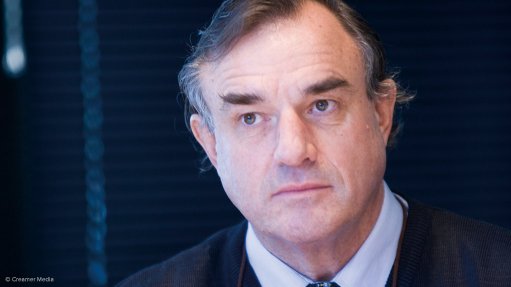
Peter Skeat
Photo by: Duane Daws
JOHANNESBURG – South African mining veteran Peter Skeat is pressing ahead with plans to squeeze more gold out of an 80-year old ransacked gold mine west of Johannesburg after settling a dispute with three former partners.
The entrepreneur, who is part-financing the venture himself, is seeking investors to help fund a revised development plan at the Blyvooruitzicht mine after receiving a 30-year mining right for the operation on April 6.
Skeat, 63, plans to spend as much as $100-million rebuilding Blyvooruitzicht. While the mine was once among the world’s top producers, its recent history has been tumultuous. The site was overrun by illegal miners and equipment looted after it was abandoned by the previous owners in 2013.
That’s not deterring Skeat, who says there’s still 27-million ounces of gold resources left to be extracted, including about one-million contained in massive pillars left behind to support shafts during the mine’s early development. Those alone, which the entrepreneur calls his “ace card,” could be mined at low cost for a decade, he said.
DISPUTE SETTLED
Blyvoor “has been through some hard times, but we’re confident in our plan to get this producing at the lowest cost for any underground mine” in South Africa, Skeat said. The support structures contain relatively high grade ore and can be mined because they’re redundant, he said.
The mine was placed in liquidation in 2013, costing about 1 700 workers their jobs, and the site fell into ruins. When Skeat bought the mine in 2015, he teamed up with brothers Bastiat and Dane Viljoen and another director, Karel Potgieter. The group planned to focus initially on reprocessing old waste dumps before the relationship soured. The dispute about scrap metal sales has now been settled and the three directors have left the venture.
At an average of about 13 g/t of gold, about three times higher than a typical South African gold mine, Skeat says he can produce some 100 000 oz/y from the pillars at all-in-sustaining costs of $600/oz. Gold has climbed almost 10% this year and traded at about $1 256/oz in London on Tuesday.
Skeat, who made his name in South African openpit and waste mining in the 1980s, previously ran miners including Aflease Gold & Uranium Resources, Mintails and Galaxy Gold Mining.
Reviving Blyvooruitzicht won’t be easy, according to Ferdi Dippenaar, who said he mined pillars when he was CEO of Village Main Reef, the last operator. “It’s old infrastructure, a lot of maintenance, with a lot of seismic activity,” he said in a phone interview. Intensive mining can increase the likelihood of seismic events. “If you’re mining remnant pillars in old areas, it’s always going to be difficult,” he said.
Another concern is the environmental risks posed by such an old mine, according to Mariette Liefferink, CEO of the Federation for a Sustainable Environment, a local community organisation. While the FSE is not opposed to Skeat’s plan, it wants more detail on how water will be used and its quality controlled, and has voiced concerns over where waste material will be dumped in the long term, Liefferink said by email.
Blyvooruitzicht, which means Happy Prospect in Dutch, was one of the world’s biggest and most profitable gold mines in the 1950s and 1960s, according to “Golden Age,” a 1968 book chronicling South Africa’s mining industry. It is situated in the heart of South Africa’s Witwatersrand Basin, which has produced almost half of the world’s gold.